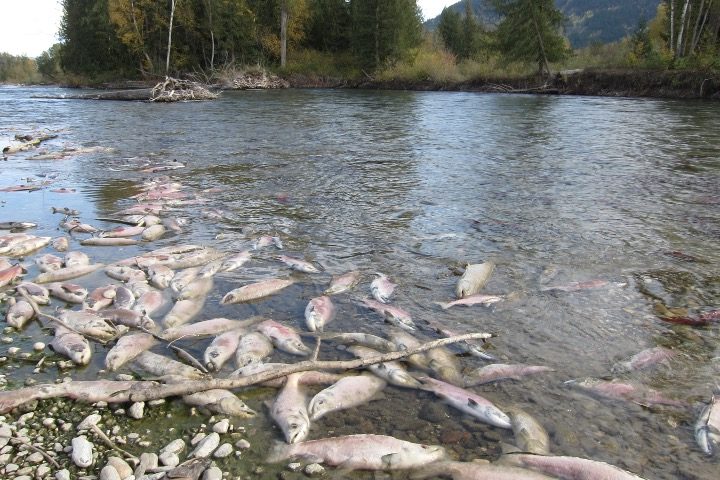
“Bring the salmon home. Remove the Klamath dams,” read a banner protesters displayed in California years ago. Now the dams have been removed — and, as a result, approximately 830,000 juvenile salmon were damned to death (trout were killed, too). This was unforeseen by the greentopian dam destroyers, and Golden State Governor Gavin Newsom, who backed the project, now wants federal disaster aid and economic assistance.
Oh, this doesn’t mean Newsom’s administration is taking any responsibility. Instead, its officials are blaming, in part, wait for it … climate change!
Yet the un-dammed water gets muddier still. The California Department of Fish and Wildlife claims the dead salmon were “excess” fish and that overall populations won’t be affected.
Despite this, salmon fishing off California’s coast has been banned for the second year running, “in response to near-historically low stock abundance forecasts for the fall Chinook runs of salmon originating from the Sacramento and Klamath rivers,” explains California Lieutenant Governor Eleni Kounalakis.
So, much like “situational values,” is this a situational crisis? California authorities seem to be saying, “There isn’t a problem — but it’s not our fault. Overall fish populations are right on target and so low that we’ve banned offshore salmon fishing and need federal disaster aid.”
Yet there’s still more to this story. The California Globe now asks if ranches will survive this disaster that is or isn’t, as the government could possibly divert water used for agriculture to the river to help flush out sediment built up due to the dams’ breaching.
Also mostly ignored is that the Klamath River dams generated hydroelectric power, the kind of “green” energy we’re supposed to cherish. What source will provide the now-sacrificed clean power?
Oh, there’s a kicker, too: Greentopians want to replicate this failure/success, removing dams nationwide in the name of, in part, “Tribal food sovereignty and cultural justice.” Yeah, you can’t make this up (though someone did).
And now let’s review. The below one-minute excerpt is an example of the kind of activism that led to the dams’ removal.
The Klamath removal project was given a federal endorsement at the end of the Obama administration, in 2016, but this was later rescinded under the Trump administration in 2019.
But Governor Newsom, of course, was all in, as per the following February headline:
“California Gov. Newsom backs dam removal projects to boost salmon. Critics say that’s not enough.”
Now the plan is a fait accompli, and, tweets the California Globe:
“The fish were believed to have been killed as a result of gas bubble disease while passing through a tunnel at the base of Iron Gate Dam, the lowest of four dams being removed on the river,” reports Jefferson Public Radio (JPR).
This isn’t a problem, however, according to Democratic California Assemblyman Jim Wood. He claims:
At least one Golden State government agency concurs, too. “‘As far as the actual populations, this is not going to harm the populations,’ said Jordan Traverso, the deputy director of communications, education and outreach for the California Department of Fish and Wildlife,” JPR also informs.
“According to Traverso, the fish that perished were in excess of the numbers the hatchery had expected to produce, so their overall production is still on target,” the outlet continues.
Perhaps true. But then why has California again now banned offshore fishing (just coincidentally?) in the wake of the dam removals? Why is the state begging for federal aid?
In her “Federal Fishery Disaster Request,” Lieutenant Governor Kounalakis blames “prolonged and historic drought, severe wildfires, impacts to spawning and rearing habitat, harmful algal blooms, and ocean forage shifts and associated thiamine deficiency” for the fish population “collapse.” For good measure, of course, she throws in that “extreme climate disruption is compounding these factors” (what else?).
Obviously, it’s a complicated picture. But then there’s what we can know. As scholar Thomas Sowell has often noted, most of us have expertise in only a very narrow range of endeavor — and, I’ll add, politicians and bureaucrats are generally as narrow as anyone. Consequently, they usually muck things up when attempting to micromanage life, the Universe, and everything (hat tip to Douglas Adams). Lacking wisdom, they don’t know what they don’t know — and usually don’t care.
Given this, more worrisome still is that activists want to destroy dams nationwide. Environmentalist organization American Rivers (AR), for instance, which stated it was “giddy” over the Klamath removals, writes that it aims to see 30,000 of America’s more than 530,000 dams eliminated by 2050.
AR claims that many of the dams no longer provide flood mitigation, irrigation, hydropower, or the other benefits they were originally designed to deliver and that some now just cost their owners money. Perhaps. But are these greentopians unbiased analysts?
For the record, I appreciate untouched wilderness as much as anyone. In fact, I love it.
But I don’t worship it.
That’s the difference, too. Greentopians won’t consider other priorities, such as facilitating human habitation, which is objectively speaking a good. And this dam destruction aim smacks of the “degrowth” agenda, whose proponents consider man a planetary infestation.
What really gives the game away is that AR tries to sell its goals partially with, again, that uber-woke “Tribal food sovereignty and cultural justice” appeal. Yet the reality is that American Indians — who had a stone-age civilization upon Europeans’ New World arrival — benefit from modernity along with the rest of us.
It took our ancestors centuries, countless billions of dollars and blood, sweat, and tears to develop the infrastructure they’ve bequeathed to us. If we destroy it on the word of greentopian radicals and oily politicians, we are fools, indeed.



